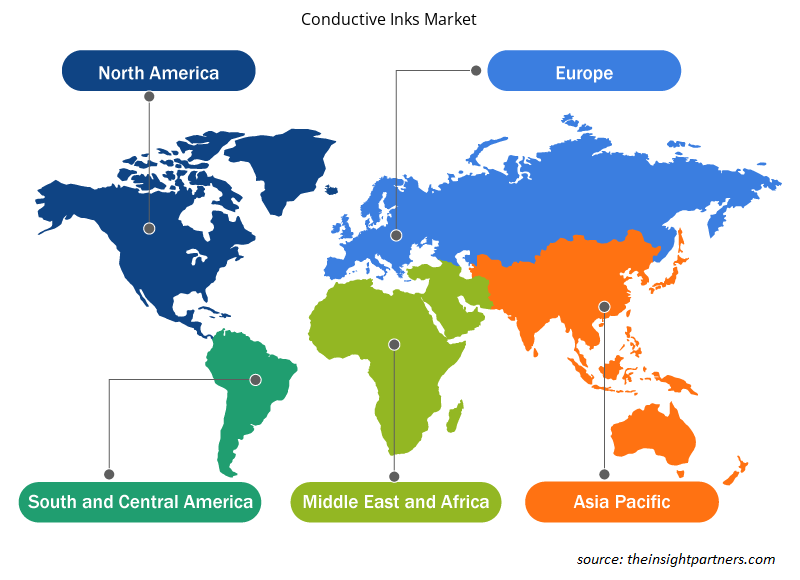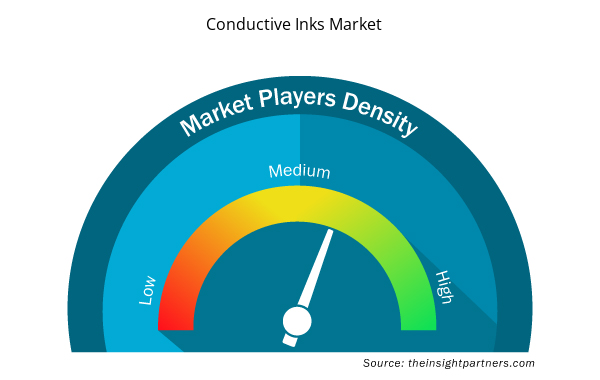[Research Report] The conductive inks market is expected to grow from US$ 3,565.80 million in 2021 to US$ 5,119.80 million by 2028; it is estimated to grow at a CAGR of 5.4% from 2022 to 2028.
Governments across the world have enacted environmental restrictions to encourage industries to replace heavy materials in devices with modern lightweight materials. In addition, consumer desire for tiny and lightweight electronics has pushed the consumer electronics industry to miniaturize its products. Moreover, rapidly increasing IoT-based applications and growing miniaturization trend are expected to drive the demand for conductive inks market. The rapidly increasing usage of smartphones and connected devices propels the need for smaller and lighter sensors with low-power requirements and enhanced performance, which stimulates the demand for miniaturization. China dominates the entire value chain of the global electronics manufacturing business and is heavily investing in new techniques to create miniaturized electronics products rapidly. Thus, the growing demand for miniaturization in smartphones, wearables, and other gadgets and rise in the demand of efficient electronic devices and bolsters the conductive inks market size.
Customize This Report To Suit Your Requirement
You will get customization on any report - free of charge - including parts of this report, or country-level analysis, Excel Data pack, as well as avail great offers and discounts for start-ups & universities
Conductive Inks Market: Strategic Insights

- Get Top Key Market Trends of this report.This FREE sample will include data analysis, ranging from market trends to estimates and forecasts.
Customize This Report To Suit Your Requirement
You will get customization on any report - free of charge - including parts of this report, or country-level analysis, Excel Data pack, as well as avail great offers and discounts for start-ups & universities
Conductive Inks Market: Strategic Insights

- Get Top Key Market Trends of this report.This FREE sample will include data analysis, ranging from market trends to estimates and forecasts.
Impact of COVID-19 Pandemic on Conductive Inks Market
Many flexible and printed electronics industries faced labor shortages because of COVID-19 pandemic. The demand for conductive ink in printed electronic applications, such as RFID tags printing used in modern transit tickets and windshield defrosters in automotive vehicles is contributing towards the conductive inks market growth. In addition, the decline in production in the automotive industry has negatively impacted the market. As per the International Organization of Motor Vehicle Manufacturers (OICA), the global sales of all vehicles in 2019 and 2020 were 91,227,182 and 78,774,320, respectively. Thus, the decline in sales of the vehicles is negatively impacting the market as conductive ink is used for the application of automotive circuits and printed defrosters, especially on rear windows, in automotive vehicles. However, from the mid-2021, the resumption of oil extraction projects is driving the conductive inks market growth. However, before the pandemic, the growing automotive industry in North America, rising penetration of electric vehicles, and increasing awareness regarding health propelled the demand for miniaturization of devices. The consumer electronic industry has witnessed a growth. Also, the rising demand for small and lightweight electronics, such sports wearables watches, and electronic medical devices to monitor health is bolstering the growth of the conductive inks market.
Market Insights – Conductive Inks Market
Growing Installation of Solar Panels Propels Conductive Inks Market Growth
The increasing energy demands necessitates utilizing alternative energy sources. As a result, renewable energy sources, especially solar energy, are now being used to generate electricity. The increasing uptake of solar energy for electricity generation is expected to drive the demand for solar-based technology and increase solar panel deployment in the years to come. That will create an opportunity for the conductive inks market in the photovoltaic application. Using inkjet printing, conductive ink makes printed organic photovoltaic solar cell panels on very thin, flexible surfaces. The solar (photovoltaic) sector has been under substantial pressure to cut raw material costs and boost production efficiency to compete with existing grid power systems. In this case, conductive inks are a potential solution for the industry, thus driving the conductive inks market.
Type-Based Insights
Based on type, the conductive inks market is segmented into silver conductive ink, carbon conductive ink, polymer conductive ink, copper conductive ink, and others. The carbon conductive ink segment held the largest market share in 2021. Carbon conductive inks are lubricious, providing low friction and excellent thermal stability. The inks are used in screen-printing, dipping, and syringe dispensing, and features excellent adhesion glass and a variety of other substrates. Unlike conventional conductive material, carbon inks are resistant to abrasion, scratching, flexing, and creasing. The development of conductive inks was aided by the rapid growth of the printed electronics sector. Carbon-based conductive inks' conductive fillers had a wide supply, low price, good stability, and a lot of application value. Nanoshel LLC, Henkel, and Dycotec Materials Ltd, are among the major players in the carbon conductive inks market. The presence of these players is contributing to the market growth.
Players operating in the conductive inks market are mainly focused on the development of advanced and efficient products.
- In 2022, DuPont Microcircuit and Component Materials business announced the launch of 5881, a new Silver/Silver Chloride conductive ink/paste for healthcare applications.
- In 2021, DuPont announced that it has successfully completed the acquisition of Laird Performance Materials, a world leader in high-performance electromagnetic shielding and thermal management solutions.
Conductive Inks Market Regional Insights
The regional trends and factors influencing the Conductive Inks Market throughout the forecast period have been thoroughly explained by the analysts at Insight Partners. This section also discusses Conductive Inks Market segments and geography across North America, Europe, Asia Pacific, Middle East and Africa, and South and Central America.

- Get the Regional Specific Data for Conductive Inks Market
Conductive Inks Market Report Scope
| Report Attribute | Details |
|---|---|
| Market size in 2021 | US$ 3.57 Billion |
| Market Size by 2028 | US$ 5.12 Billion |
| Global CAGR (2021 - 2028) | 5.4% |
| Historical Data | 2019-2020 |
| Forecast period | 2022-2028 |
| Segments Covered |
By Type
|
| Regions and Countries Covered | North America
|
| Market leaders and key company profiles |
Conductive Inks Market Players Density: Understanding Its Impact on Business Dynamics
The Conductive Inks Market market is growing rapidly, driven by increasing end-user demand due to factors such as evolving consumer preferences, technological advancements, and greater awareness of the product's benefits. As demand rises, businesses are expanding their offerings, innovating to meet consumer needs, and capitalizing on emerging trends, which further fuels market growth.
Market players density refers to the distribution of firms or companies operating within a particular market or industry. It indicates how many competitors (market players) are present in a given market space relative to its size or total market value.
Major Companies operating in the Conductive Inks Market are:
- Molex
- DuPont
- Henkel AG & Co. KGaA
- Inkron (Nagase Group)
- InkTec
Disclaimer: The companies listed above are not ranked in any particular order.

- Get the Conductive Inks Market top key players overview
The conductive inks market is segmented on the basis of type and application. Based on type, the market is segmented into silver conductive ink, carbon conductive ink, polymer conductive ink, copper conductive ink, and others. In 2021, the carbon conductive ink segment led the market and accounted for the largest market share. In terms of application, the market is segmented into solar panels, touch screens, membrane switches, medical devices, printed circuit boards, sensors, heating elements, radio frequency identification, cell phone antennas, automotive, and others. In 2021, the printed circuit board segment led the market and accounted for the largest market share. Geographically, the conductive inks market is broadly segmented into North America, Europe, Asia Pacific (APAC), Middle East & Africa (MEA), and South America (SAM). In 2021, APAC accounted for a significant share of the global market.
Applied Ink Solutions; DuPont DE Nemours, Inc.; Henkel AG and CO. KGAA; Inkron OY; Inktec; Heraeus; Novacentrix; POLY-INK; Merck KGAA; and Vorbeck Materials Corporation are among the major companies operating in the conductive inks market players.
- Historical Analysis (2 Years), Base Year, Forecast (7 Years) with CAGR
- PEST and SWOT Analysis
- Market Size Value / Volume - Global, Regional, Country
- Industry and Competitive Landscape
- Excel Dataset



Report Coverage
Revenue forecast, Company Analysis, Industry landscape, Growth factors, and Trends

Segment Covered
Type and Application

Regional Scope
North America, Europe, Asia Pacific, Middle East & Africa, South & Central America

Country Scope
Argentina, Australia, Brazil, Canada, China, France, Germany, India, Italy, Japan, Mexico, Russian Federation, Saudi Arabia, South AFrica, South Korea, United Arab Emirates, United Kingdom, United States
Frequently Asked Questions
The top five key players operating in the conductive inks markets Dupont de Nemours, Inc., Henkel AG & Co. KGaA, NovaCentrix, MERCK KGaA, and Heraeus Holding GmbH are among the key players profiled in the research study on the conductive inks market. The companies engage themselves in designing and developing conductive inks with competitive pricing which enables the manufacturers to attract customers, thereby, gaining market share
Based on application, the conductive inks market is segmented into solar panels, touch screens, membrane switches, medical devices, printed circuit boards, sensors, heating elements, radio frequency identification, cell phone antennas, automotive glass, etc. The printed circuit board segment accounted for the largest share in the conductive inks market in 2021. A printed circuit board is a rigid structure that contains an electrical circuit made of embedded metal wires called traces and larger areas of metal called planes. The high-performance conductive inks and adhesive materials can withstand high-temperature processing used in the manufacture of printed circuit boards and are contributing to the market growth.
Based on type, the conductive ink market is segmented into silver conductive ink, carbon conductive ink, polymer conductive ink, copper conductive ink, and others. The carbon conductive ink segment accounted for a larger share of the conductive ink market in 2021. Carbon conductive inks are lubricious, providing low friction and excellent thermal stability. The development of conductive inks was aided by the rapid growth of the printed electronics sector. Carbon-based conductive inks' conductive fillers had a wide supply, low price, good stability, and a lot of application value.
The rising adoption of conductive ink in various applications sectors such as 5G, automotive photovoltaic, power electronics, package-level EMI shielding, In-Mold Electronics, electronic textile and wearable electronics, skin patches, RFID, and others. The automotive industry has been a key target market for conductive ink manufacturers. Printed defrosters, particularly on rear windows, are a typical application. The use of transparent and efficient large-area heating to minimize apparent defroster lines is an important development. In Furthermore, seat heaters are also a notable market with ample upside growth opportunities.
The use of conductive inks in printing RFID chips has several advantages, such as reduced size and fast and efficient production, resulting in low production costs. In addition, the RFID tag's antenna is used to distribute frequency signals and establish a wireless link between the tag and the reader. Traditional antenna manufacturing methods are expensive and have slow production speeds. Also, they pollute the environment. To address these drawbacks, the technology of printing antennas with conductive ink is being used. Thus, the growing adoption of RFID technology drives the conductive inks market growth.
Trends and growth analysis reports related to Electronics and Semiconductor : READ MORE..
The List of Companies - Conductive Inks Market
- Molex
- DuPont
- Henkel AG & Co. KGaA
- Inkron (Nagase Group)
- InkTec
- Heraeus
- NovaCentrix
- Poly-Ink
- Merck KGaA
- Vorbeck Materials Corporation

 Get Free Sample For
Get Free Sample For